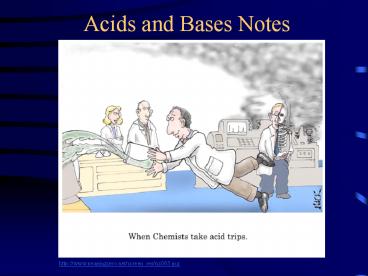Acids and Bases Notes - PowerPoint PPT Presentation
Title:
Acids and Bases Notes
Description:
Acids and Bases Notes http://www.nearingzero.net/screen_res/nz065.jpg I. Strength of Acids and Bases A. Bases: Strong Bases: metal hydroxides of Group I and II metals ... – PowerPoint PPT presentation
Number of Views:164
Avg rating:3.0/5.0
Title: Acids and Bases Notes
1
Acids and Bases Notes
http//www.nearingzero.net/screen_res/nz065.jpg
2
I. Strength of Acids and Bases
- A. Bases
- Strong Bases metal hydroxides of Group I and II
metals (except Be) that are soluble in water and
dissociate (separates into ions) completely in
dilute aqueous solutions - Weak Bases a molecular substance that ionizes
only slightly in water to produce an alkaline
(basic) solution (ex. NH3)
3
My uncle was a chemist, a chemist he's no more
for what he thought was H 2 O was H 2 S O 4.
(Ha Ha)
- B. Acids
- Strong Acids an acid that ionizes (separates
into ions) completely or very nearly completely
in aqueous solutions (will not be on Ka chart). - Weak Acids an acid that ionizes only slightly
in dilute aqueous solutions (will be on the Ka
chart).
4
Why do white bears dissolve in water? Because
they're polar.
- 1. Binary or hydrohalic acids HF, HCl, HBr,
HI, etc. hydro____ic acid are usually strong
acids - HF and H2S are weak hydrohalic acid. Although
the H-F bond is very polar, the bond is so strong
(due to the small F atom) that the acid does not
completely ionize.
5
Acids
- Have a sour taste.
6
Acids
- Turn blue litmus red.
- Turn methyl orange red.
7
Acids
- Will react with
- some metals to produce a salt and H2.
- metal oxides to produce a salt and H2O.
- metal carbonates to produce a salt, H2O, and CO2.
- bases to produce a salt and H2O.
- Mg 2HCl ? MgCl2 H2
- MgO 2HCl ? MgCl2 H2O
- MgCO3 2HCl ? MgCl2 H2O CO2
- Mg(OH)2 2HCl ? MgCl2 2H2O
8
Acids
- Are electrolytes.
- Conduct an electric current when dissolved.
9
Bases
- Have a bitter taste.
Coffee itself is acidic, but it contains an
alkaline compound caffeine which contributes
to its bitter taste.
10
Bases
- Feel slimy or slippery to the touch.
11
Bases
- Turn red litmus blue.
- Turn methyl orange yellow.
- Turn phenolphthalein pink.
Litmus pH scale.
12
Bases
- React with acids to produce salt and H2O.
- HCl NaOH ? NaCl H2O
13
Bases
- Are electrolytes.































